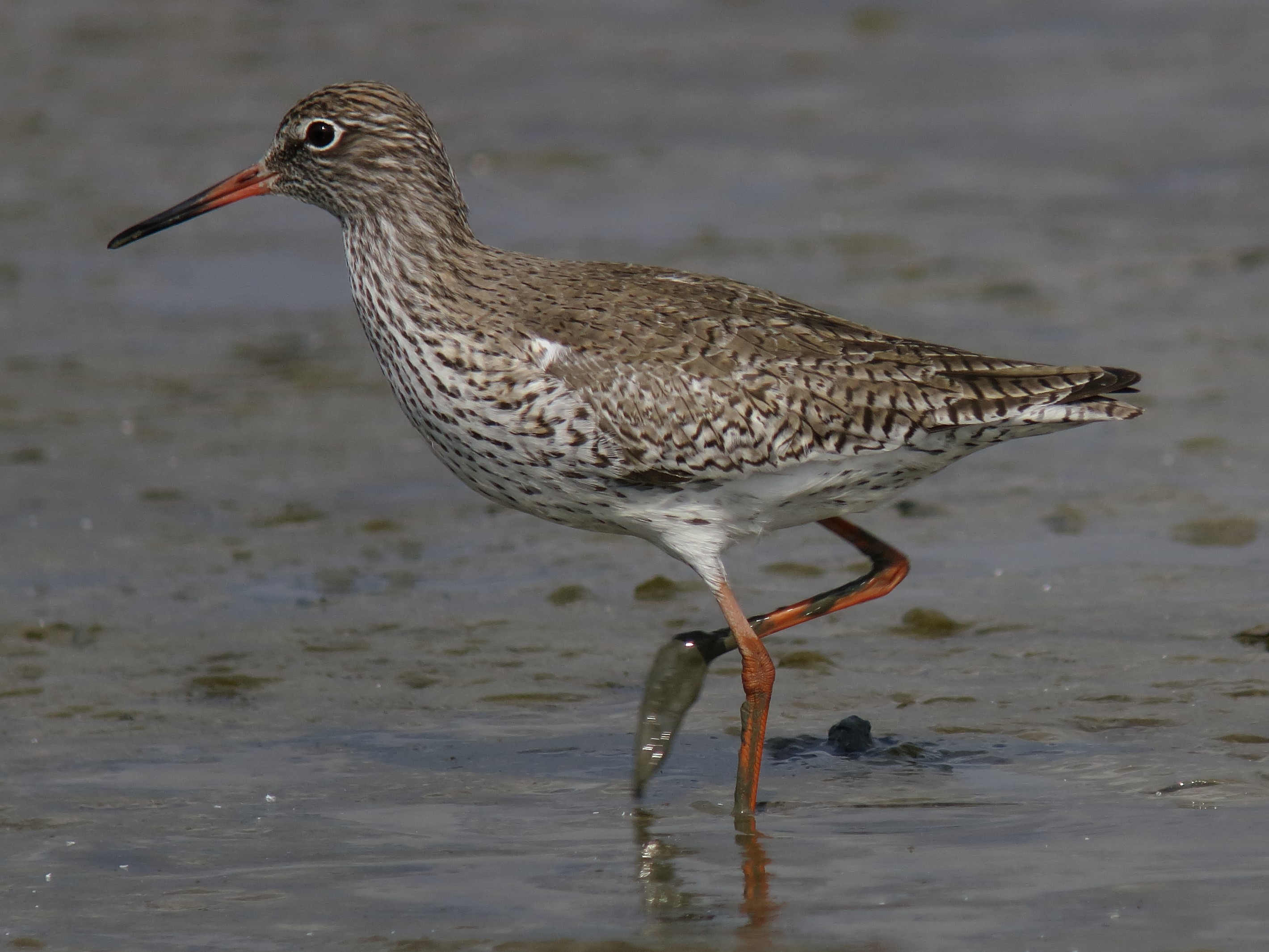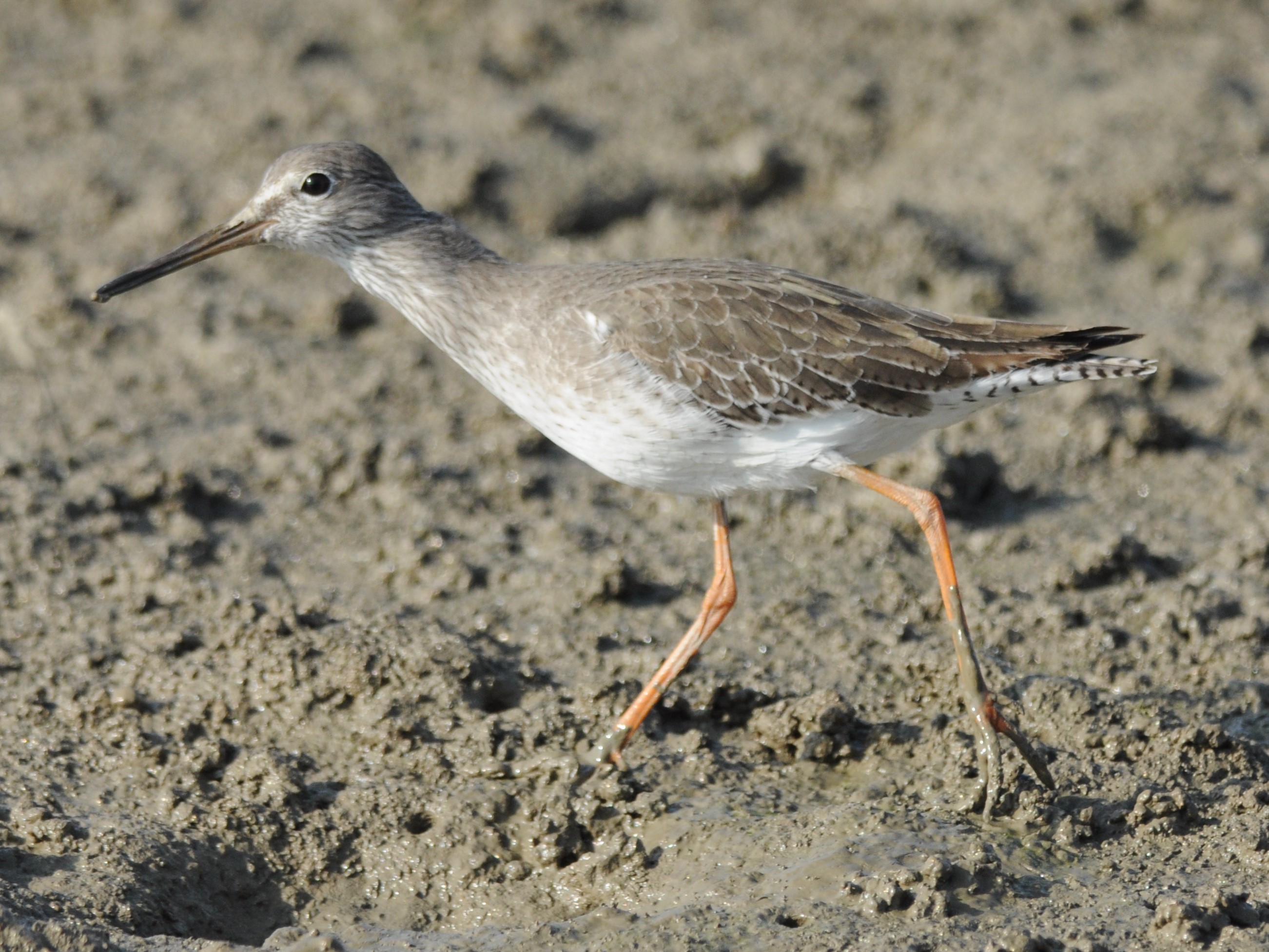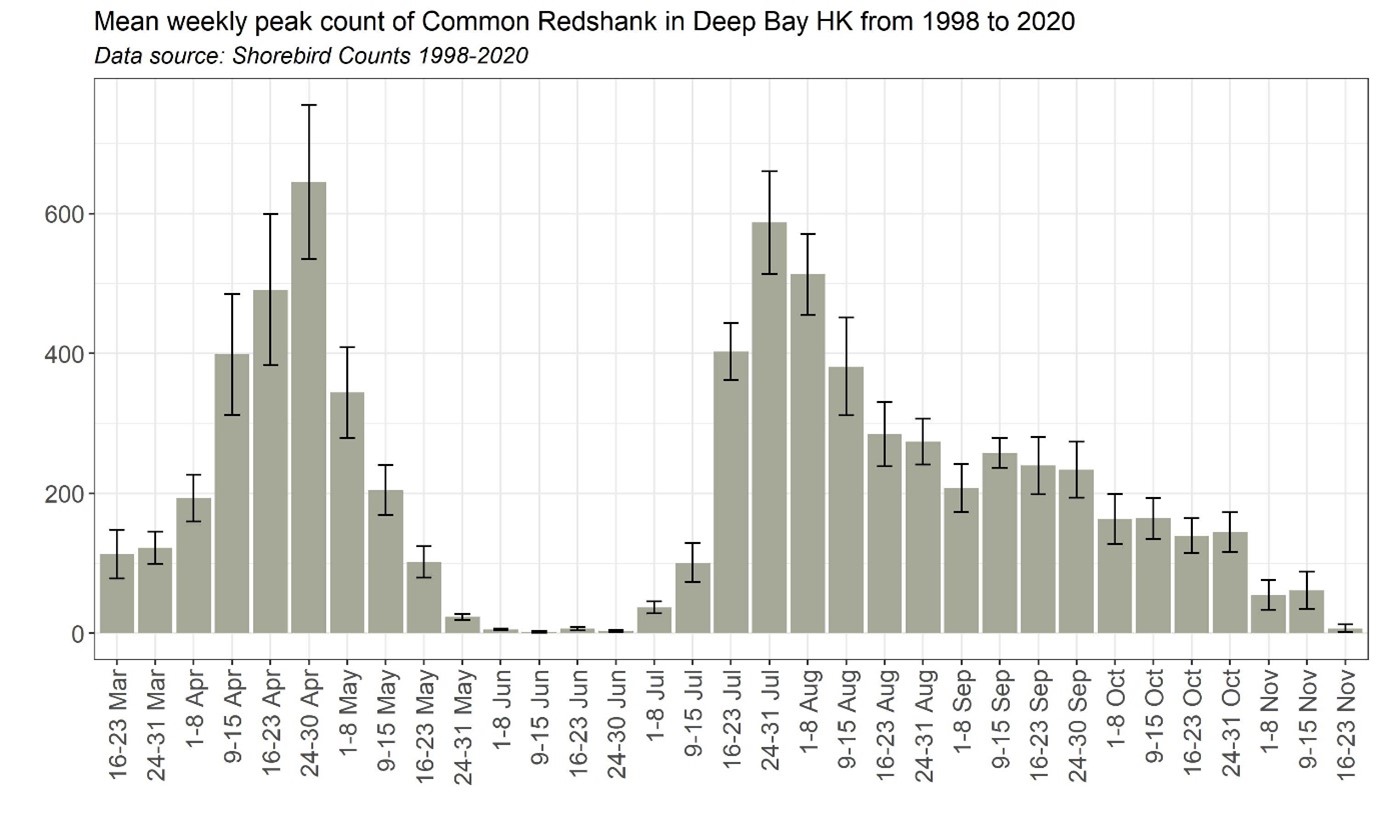Common Redshank Tringa totanus 紅腳鷸
Category I. Abundant in autumn, winter and spring, but evidence of a decline in numbers on passage, especially in spring. Winter numbers are higher than in the 1990s.
IDENTIFICATION

Apr. 2017, CHUNG Yun Tak. Breeding plumage.
27-29 cm. Medium-sized shorebird with orange to red legs and orange base to bill. Brown above with streaked chest and flanks, whitish supercilium in front of the eye. Adult breeding has variable dark marks on upperparts.
Differs from Spotted Redshank by wing pattern in flight, less elegant proportions, shorter legs and bill (the latter less fine with the reddish base including upper mandible) and less obvious supercilium above lores when not in breeding plumage.

Sep. 2020, Sarawak, Malaysia. Dave Bakewell. Juvenile.
In flight shows largely white secondaries and inner primaries that contrast markedly with the rest of the wing, a broad white tapered flash from the rump up to the back and barred tail and uppertail coverts. The uniformly-aged wing coverts with broad white fringes and dark subterminal marks indicate this is a juvenile, many of which have only orange-red legs.

Dec. 2015, CHUNG Yun Tak.
In winter plumage overall paler, and plainer both above and below.
VOCALISATIONS
A very vocal species, even on wintering grounds.
When alert a drawn out ‘tyooo’ is uttered, and when flushed a short series of 2-3 notes: ‘tee-yoo’, ‘chee-chi-chi’ or ‘chee-tu-tu’
The alarm call is a rapidly repeated ‘chik’ or ‘choo’.
A commonly heard call is a slurred ‘tyoo-yoo-yoo’
Occasionally a variant of the above call is given that resembles the typical flight call of Common Greenshank but is lower in pitch.
DISTRIBUTION & HABITAT PREFERENCE
Most records are from the intertidal mudflats of Deep Bay and adjacent roosting areas, primarily Mai Po NR. Up to three have been recorded at Long Valley, though it is not annual there. Other records have occurred at a small number of coastal sites throughout the territory and generally involve up to eight birds, with the highest count being 24 at Sai Kung on 30 April 1977.
OCCURRENCE
Common Redshank can be seen all year round though it is primarily a passage migrant, with similar numbers occurring in spring and autumn, and is scarce in summer (Figure 1).
By the second half of March substantial numbers of migrants are usually present ahead of the rather extended main passage period in April and the first half of May, with the highest numbers occurring in the last week of April. Historically, the highest counts in HK are 3,474 on 29 April 1994 and 2,330 on 22 April 1995. These are larger than the highest spring count this century, which is 1,980 on 23 April 2001, and considerably greater than spring counts since 2004. However, in the whole Deep Bay area on 19 April 2008 a count of 3,539 was made, of which 2,832 were on the Shenzhen side. Figure 2 indicates a further decline has occurred since 2009, with the highest spring count since then being 831.
Very low numbers are generally present in the summer, while the first migrants appear in the first week of July. Peak passage occurs during the second half of July and the first half of August. Many of these birds appear to be moulting individuals, and it may be that Deep Bay is important as a moulting area at this time.
Whereas in the 1990s Common Redshank was significantly more numerous in spring than autumn, since 2015 peak spring and autumn counts have been broadly similar. The highest autumn counts are 2,471 on 7 August 1994 and 1,470 on 30 July 2006.
Figure 3 illustrates the trend of peak midwinter counts, and in contrast to the situation in spring and autumn, since at least 2015 higher numbers have been present than was the case in the second half of the 1990s, though similar to the early part of the decade. The highest midwinter count is 995 on 10 February 2019.
Vaughan and Jones (1913) noted that Common Redshank occurred on passage and in winter from 26 August to 18 April. Dove and Goodhart (1955) recorded it as a migrant from 16 August to 18 September and 9 April to 25 May, though it was not common. Macfarlane and Macdonald (1966) stated that it was a passage migrant with occasional winter records, involving up to 80 birds from 18 July to 24 June.
BEHAVIOUR, FORAGING & DIET
Gregarious, occurs in flocks throughout the year. Foraging generally involves pecking while undergoing a rapid walk; occasionally sweeps bill through water or probes in mud.
RANGE & SYSTEMATICS
Breeds from Britain and Scandinavia southeast through eastern Europe, western Russia, Kazakhstan, Mongolia to Ussuriland and north and west China excluding high altitude areas; winters largely to the south in Africa, Middle East, Indian subcontinent, Indochina, southeast Asia, south China, the Philippines and Indonesia to scattered areas in Australia (Van Gils et al. 2020). In China it breeds in the west, north and northeast, and winters from the Yangtze to the south coast, including Hainan and Taiwan (Liu and Chen 2020).
Six subspecies are recognised, three of which could conceivably occur in HK. These are T. t. ussuriensis (south Siberia to east Asia), T. t. terrignotae (south Manchuria and east China) and, less likely, T. t. craggi (northwest China).
CONSERVATION STATUS
IUCN: Least Concern. Population trend unknown.
Figure 1.

Figure 2.

Figure 3.

Dove, R. S. and H. J. Goodhart (1955). Field observations from the Colony of Hong Kong. Ibis 97: 311-340.
Liu, Y. and Y. H. Chen (eds) (2020). The CNG Field Guide to the Birds of China (in Chinese). Hunan Science and Technology Publication House, Changsha.
Macfarlane, A. M. and A. D. Macdonald, revised by Caunter, J.R.L. and A.M. Macfarlane (1966). An Annotated Check-list of the Birds of Hong Kong. Hong Kong Bird Watching Society, Hong Kong.
Van Gils, J., P. Wiersma, and G. M. Kirwan (2020). Common Redshank (Tringa totanus), version 1.0. In Birds of the World (J. del Hoyo, A. Elliott, J. Sargatal, D. A. Christie, and E. de Juana, Editors). Cornell Lab of Ornithology, Ithaca, NY, USA. https://doi.org/10.2173/bow.comred1.01
Vaughan, R. E. and K. H. Jones (1913). The birds of Hong Kong, Macao and the West River or Si Kiang in South-East China, with special reference to their nidification and seasonal movements. Ibis 1913: 17-76, 163-201, 351-384.

